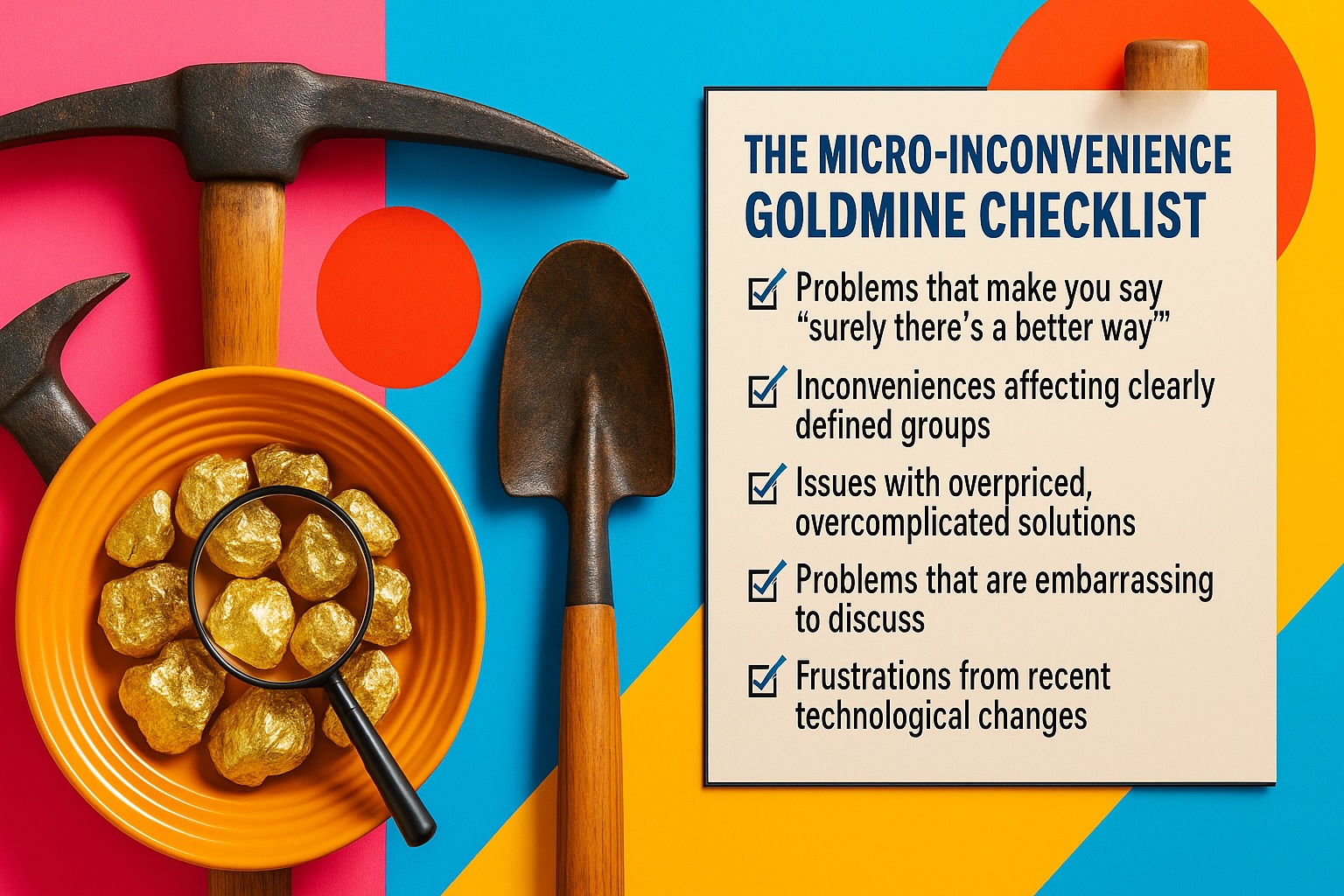The 'Micro-Inconvenience' Mining Method: Finding Million-Dollar Problems in 30-Second Frustrations
That split second when your phone charger doesn't plug in the right way? Congratulations, you've just discovered venture capital gold. Turns out the most profitable problems aren't world hunger—they're the tiny daily tortures that make us want to throw our devices out the window.
Turning Your "FFS" Moments into "£££" Opportunities: The Art of Micro-Inconvenience Mining
The most lucrative business idea you'll ever have is probably making you swear under your breath right now. That fleeting moment when you mutter "for f***'s sake" as your phone charger falls behind the bed for the nineteenth time today? That's not just irritation—that's market research in its most authentic form. While venture capitalists are busy throwing millions at the next AI-powered-blockchain-NFT-metaverse-dog-walking app, the real gold lies in those tiny, maddening micro-inconveniences that make you question the competence of our entire species.
Why Small Frustrations Make Big Businesses
Let's be honest—we've overcomplicated the concept of "innovation." We've convinced ourselves that unless we're building the next Space X or curing cancer, we're not really entrepreneurs. What utter bollocks. Some of the most profitable businesses in history were built by someone who simply got fed up with a small, persistent annoyance.
Remember when we all carried separate devices for music, phone calls, and photos? Some irritated genius at Apple said, "This is ridiculous," and now we're all walking around with £1,000 pocket computers that we primarily use to look at pictures of other people's dinners. That's the power of solving a micro-inconvenience.
Having weathered my own spectacular business failure (a luxury candle company that, ironically, burned through cash faster than its own products), I've learned that chasing grandiose visions often leads to grandiose disappointments. The businesses that endure tend to scratch very specific, very real itches. In fact, first to product-market fit (not first to market) is almost always the long-term winner, because great markets pull products out of startups, while poor markets lead to failure even with great teams.
The Daily Frustration Inventory Method
Here's where it gets interesting. Your day is absolutely riddled with potential million-pound ideas disguised as minor irritations. The trick is training yourself to notice them rather than normalising them. We humans have an extraordinary capacity to accept daily inconveniences as "just the way things are" rather than opportunities for improvement.
I call this the "Daily Frustration Inventory Method." For one week, become hyper-aware of every tiny annoyance you encounter. That moment when you're wrestling with impossible-to-open packaging? That's not just frustration—that's market research. The confusion when trying to cancel a subscription service? That's not just bad UX—that's a business opportunity.
This systematic observation approach mirrors what researchers call diary studies, which capture real-time, contextual insights into user behaviors over days or weeks. Unlike traditional interviews, they allow you to observe how frustrations and experiences evolve naturally over time. For daily annoyances, just one week of focused observation can reveal patterns that would take months to identify through other methods.
After my candle business went up in smoke (largely because I was solving a problem nobody actually had), I became obsessed with finding genuine points of friction in daily life. These micro-inconveniences became my compass for identifying real needs rather than imagined ones.
- Keep a "frustration journal" for 7 days, noting every minor annoyance you encounter
- Rate each frustration on a scale of 1-5 for frequency and intensity
- Identify patterns across different contexts (home, work, commuting, shopping)
- Look for frustrations that affect specific demographics or industries
- Pay special attention to problems you're willing to pay to solve
Validation: Is Your Micro-Inconvenience Actually Worth Solving?
The truth is, not all frustrations are created equal. Some are universal enough to build businesses around; others are just your personal quirks. (And while I'm sure there's a market for a device that automatically sorts your socks by shade and thickness, it might be limited to you and three other obsessively organised individuals.)
Before you remortgage your house to solve the problem of tangled earphones (which, let's be honest, is infuriating enough to justify serious venture capital), you need to validate that others share your pain. Remember, the best way to validate an idea is when money changes hands, proving real-world demand beyond just nodding friends and family.
The Three-Circle Test is my go-to method here. A viable micro-inconvenience business idea sits at the intersection of:
- Problems that occur frequently enough to merit a solution
- Issues that cause enough emotional friction to motivate purchase
- Solutions that can be delivered at a price point proportional to the pain
- Problems that aren't already being effectively addressed
- Issues you actually understand and care about solving

After the humbling experience of watching my candle business extinguish itself, I became ruthless about validation. I discovered that people will enthusiastically tell you they love an idea but then never open their wallets. Talk is cheap; pre-orders aren't.
From Irritation to Implementation: Building Your Micro-SaaS
Once you've identified a promising micro-inconvenience, the path to monetisation is often clearer than you might think. The beauty of solving small, specific problems is that your solution can be equally focused. This is where micro-SaaS opportunities shine brightest.
Micro-SaaS—small, targeted software services that solve specific problems—are the modern equivalent of the better mousetrap. They don't require massive teams, venture funding, or world-domination strategies. They simply need to remove a specific friction point better than existing alternatives.
Consider the humble scheduling tool. The micro-inconvenience of coordinating meetings across time zones and busy calendars has spawned multiple successful businesses. None of them are changing the fundamental nature of human communication; they're just making one annoying task less annoying. And people gladly pay for that relief.
What I've learned through my business journeys is that a laser-focused solution to a specific problem often outperforms the swiss-army-knife approach. When you're addressing a micro-inconvenience, your customers aren't looking for all-in-one solutions—they just want that one particular itch scratched effectively. Understanding how your solution compares to existing alternatives becomes crucial for positioning your focused approach effectively.
The Micro-Inconvenience Goldmine Checklist
Ready to start mining your daily frustrations for business gold? Here's your prospector's toolkit:
- Look for problems that make you say "surely there's a better way to do this" at least once a week
- Focus on inconveniences that affect clearly defined groups of people (industries, roles, demographics)
- Prioritise issues where the existing solutions feel overpriced, overcomplicated, or outdated
- Consider problems that are embarrassing or awkward enough that people avoid discussing them
- Target frustrations that have emerged recently due to technological or social changes
Having burned my fingers (quite literally, in the candle business) on grandiose ideas, I've developed a deep appreciation for the power of small solutions to specific problems. The entrepreneurs I most admire aren't the ones making headlines—they're the ones quietly solving distinct problems for grateful customers.
Beyond the Idea: From Concept to Cash Flow
Identifying the perfect micro-inconvenience is only half the battle. Turning that insight into a sustainable business requires discipline, focus, and a willingness to start embarrassingly small. This is where most would-be entrepreneurs falter—they inflate their simple solution into a bloated vision that loses the very specificity that made it valuable.
When you've found your micro-inconvenience goldmine, resist the temptation to expand your scope before you've even built version one. The beauty of solving small problems is that you can create minimum viable solutions quickly, get them into users' hands, and iterate based on real feedback rather than speculation. However, be aware that even the most magical products developed by world-class teams can suffer from years of little or no growth before taking off—your biggest competition isn't another company but the status quo.
After watching my candle business melt away (partly because I tried to be everything to everyone), I've become a fierce advocate for the power of narrow focus. Start with solving one specific micro-inconvenience exceptionally well. You can always expand later, but you can't iterate on a product that collapsed under its own ambition before it even launched.
Remember: Amazon started by selling books. Just books. Not "everything ever made by human hands plus cloud computing infrastructure plus original television content." Just. Books. There's profound wisdom in that approach.
From Personal Frustration to Market Validation
The most efficient path from identified micro-inconvenience to validated business opportunity follows a predictable pattern:
- Document your own frustration in excruciating detail (the exact moments, feelings, and workarounds)
- Find 10-15 people who might share this pain point and interview them without pitching solutions
- Create the simplest possible solution that addresses the core friction (not all peripheral issues)
- Put a price tag on it immediately—free validation is no validation at all
- Grow through the network effect of relieved customers telling others with the same problem
This approach bypasses the common entrepreneurial delusion that everyone will instantly recognise the brilliance of your solution. They won't. But people experiencing the specific pain you're addressing will beat a path to your door if you can genuinely relieve their frustration.
After my spectacular failure in the luxury goods space (turns out people are surprisingly particular about what they set on fire in their homes), I've learned that real validation comes from people opening their wallets, not nodding politely during customer interviews.
The Subtle Art of Micro-Inconvenience Pricing
Here's where things get particularly interesting. Pricing solutions to micro-inconveniences follows different rules than traditional products or services. The value isn't tied to production costs or competitor benchmarks—it's directly proportional to the emotional relief provided.
Consider the humble password manager. The micro-inconvenience of forgetting and resetting passwords is maddening enough that millions of people pay monthly subscriptions just to avoid that specific frustration. The actual technology isn't particularly revolutionary, but the relief it provides justifies the cost many times over. This connects to what customer experience researchers have discovered: customers don't remember the average of an experience; they remember the most emotionally intense moments and the end, meaning a single friction point can ruin an otherwise smooth interaction.
When pricing your micro-inconvenience solution, consider the emotional tax of the problem rather than just the functional value of your fix. People will pay surprisingly well to eliminate consistent sources of friction in their lives, especially when those frustrations trigger negative emotions like embarrassment, anxiety, or anger.
What I've learned (the hard way, through watching my own business collapse) is that people often have more emotional attachment to solving small, persistent problems than grand, abstract ones. The daily paper cut hurts more than the theoretical amputation.
The most successful micro-inconvenience businesses charge what the relief is worth, not what the solution costs to produce. That's how a simple Chrome extension can command a £9.99 monthly subscription while complex enterprise software struggles to justify its price tag.
The Final Thought: Small Solutions, Big Impact
The next time you find yourself muttering under your breath about some tiny, persistent annoyance, pause. That fleeting frustration might not just be a blip in your day—it could be the seed of your next business. The world doesn't necessarily need more revolutionary technologies or paradigm-shifting innovations. Sometimes, it just needs someone observant enough to notice the small things that make life needlessly difficult, and determined enough to smooth those edges.
After all, entrepreneurship isn't always about changing the world. Sometimes, it's simply about making it slightly less irritating, one micro-inconvenience at a time. And if you can build a thriving business by eliminating those tiny friction points? Well, there's nothing micro about that accomplishment.






